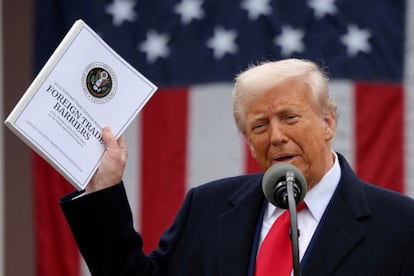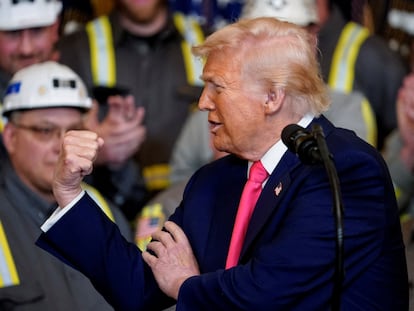The Catalan researcher cited by Trump to justify his tariffs: ‘It’s outrageous, they’re causing a recession’
The economist Pau S. Pujolas co-wrote an article on how to win a trade war that the White House used as a reference to explain its tariff formula: ‘But there’s a huge gap between my study and what they’re doing’


Being cited by the United States government, even if it’s to declare a trade war on the entire world, can be quite a rush. That’s what happened last week to the researcher Pau S. Pujolas, who saw that the article he had co-authored with his colleague Jack Rossbach was among the five bibliographical references used to justify the skewed calculation of the tariffs imposed by President Donald Trump. But the adrenaline soon gave way to something close to frustration. While it’s true that the article by Pujolas and Rossbach concludes that in a trade war between two countries, the nation with a trade deficit wins, the model used by the researchers cannot justify Trump’s measures. “There’s a huge gap between my study and what the White House is doing. It’s outrageous, they’re causing a recession,” the economist stated via video conference.
Pujolas has been explaining his article for several days now, far more than he could ever have anticipated. Born in Solsona, in the northeastern Spanish region of Catalonia, he earned a PhD from the Universitat Autònoma de Barcelona in 2013, and now works as an associate professor at McMaster University in Canada. In 2024 he co-authored an article with Rossbach, of Georgetown University in Qatar, titled Trade Wars with Trade Deficits, which was published in preprint form. That is to say, it has not yet passed the peer review required for final publication in a scientific journal. But this didn’t bother the Trump administration, which included the article in the references to justify the tariff calculations. On Monday, the White House made public the more extensive reflections made at the Hudson Institute by Steve Miran, chairman of Trump’s Council of Economic Advisers. And in them, he again cites the article by the two researchers.
“More recent economic analyses allow for the possibility of persistent trade deficits that resist automatically rebalancing, which is more in line with reality in the U.S. They show that by imposing tariffs against exporting countries, the U.S. can improve economic outcomes, raise revenues, and impose huge losses for the tariffed nation, even with full retaliation,” Miran noted, citing the article.
“This is exactly what my article says,” Pujolas explains. But he adds: “Miran and the Council of Economic Advisers are very smart, but I know that what the White House is doing isn’t necessarily what these advisors are telling it to do. The formula and tables that Trump used as if he were Moses have nothing to do with my article or with the articles that were cited.”

The article is an economic analysis of who would win in a trade war between the United States and China. It uses 2014 data as a reference — so that it’s not contaminated by the trade wars that began during the first Trump administration — and develops a model using supercomputer calculations. “When a government imposes tariffs, it’s because it’s the most optimal thing to do: it gets to keep money that companies were previously keeping to themselves. If the tariff is small, the money it collects is greater than the damage it does to its economy. But the other government also decides to impose tariffs because it’s also the most optimal thing to do. And at the end of the day, both are poorer. This is what has always been accepted as true,” explains Pujolas.
“But what happens when there’s a trade deficit between the two, something that can happen for a thousand reasons? Does this change the way we think about trade wars? What we saw is that if the trade deficit is large enough, it’s a good idea to impose a tariff,” he points out. The reason is that if the United States buys more products from China than it sells to them, at the end of the escalation — calculated by the supercomputer — the one who will be most harmed is the one with the most products to sell, that is, China. “We created a very comprehensive model and asked it if the United States would benefit from imposing an optimal tariff on China, and it said yes. But the tariffs they imposed in 2018 weren’t optimal, and therefore they’ve already lost that trade war. And if you include the outrageous tariffs that Trump has imposed now into our model, they’re sure to lose. They’re beyond measure, and it goes beyond China: a trade war against the European Union, with which they have a smaller deficit, makes no sense.”
In the model the researchers used, they didn’t consider other variables such as debt or the fiscal deficit, nor the role of the dollar, elements that also weigh heavily on how the U.S. economy is behaving in the current trade war. Pujolas and Rossbach only analyzed the trade deficit. “And we were proposing tariffs of 10% or 15%, not the ones he’s implementing. And our article doesn’t say you should be an erratic leader who wants Greenland or wants to make Canada the 51st state. All of this also creates confusion,” the researcher quips.
Sign up for our weekly newsletter to get more English-language news coverage from EL PAÍS USA Edition
Tu suscripción se está usando en otro dispositivo
¿Quieres añadir otro usuario a tu suscripción?
Si continúas leyendo en este dispositivo, no se podrá leer en el otro.
FlechaTu suscripción se está usando en otro dispositivo y solo puedes acceder a EL PAÍS desde un dispositivo a la vez.
Si quieres compartir tu cuenta, cambia tu suscripción a la modalidad Premium, así podrás añadir otro usuario. Cada uno accederá con su propia cuenta de email, lo que os permitirá personalizar vuestra experiencia en EL PAÍS.
¿Tienes una suscripción de empresa? Accede aquí para contratar más cuentas.
En el caso de no saber quién está usando tu cuenta, te recomendamos cambiar tu contraseña aquí.
Si decides continuar compartiendo tu cuenta, este mensaje se mostrará en tu dispositivo y en el de la otra persona que está usando tu cuenta de forma indefinida, afectando a tu experiencia de lectura. Puedes consultar aquí los términos y condiciones de la suscripción digital.
